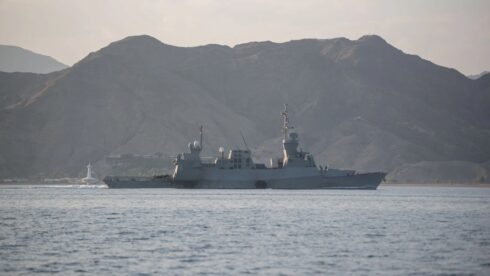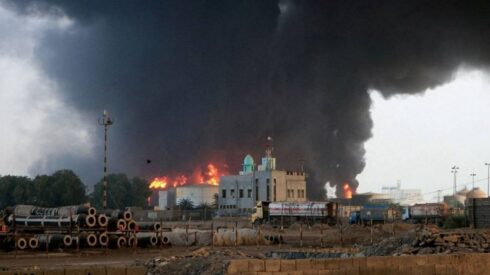The Israeli Navy launched strikes against infrastructure at the Yemen port of al-Hodeida, which is controlled by the Houthis (Ansar Allah), in the first such attack since the start of the crisis in the Red Sea.
In a statement, the Israeli Defense Forces (IDF) said that the strikes were carried out in response to recent Houthi missile and drone attacks on Israel,
Sa’ar 6-class corvettes were involved in the attack, during which two long-range guided missiles were fired at the port from hundreds of kilometers away, according to the military, which didn’t provide any details on the type of the missiles used in the attack.
Israeli military officials said that warships are used for certain strikes instead of the traditional fighter jets or drones, due to their constant availability at sea and because the attacks can be launched more discreetly.
No casualties were reported by Houthi-run media, which also didn’t share any video footage showing the aftermath of the strikes. A photo posted to social networks showed some of the damage, however.
This was the fifth Israeli attack to target Yemen since last month, with the Israeli Air Force carrying out all previous four which also targeted civilian infrastructure.
The Houthis hit back quickly, announcing an attack with two ballistic missiles, a hypersonic Palestine-2 and a Zulfiqar, at Ben Gurion Airport in central Israel.
“The Yemeni Armed Forces confirm that the decision to ban air traffic to the aforementioned airport remains in effect, and reiterates its warning to the remaining companies that they must immediately halt all flights to and from the airport,” Houthi spokesman Brig. Gen. Yahya Saree said in a statement.
“In response to the aggression on al-Hodeidah, the Yemeni Armed Forces warn all companies and various entities against continuing to deal with the port of Haifa, which has become a target,” he added.
The IDF said that one ballistic missile launched by the Houthis from Yemen was intercepted by air defenses. Sirens had sounded across central Israel, the Jerusalem area, southern West Bank settlements, and some areas in southern Israel amid the attack, but no casualties or losses were reported.
The missile broke up into multiple parts after being hit by an interceptor, leading the Israeli Air Force to launch additional interceptors to shoot down the fragments, according to the military, which noted that at least seven interceptors were seen launched.
Since March 18, when the IDF resumed its offensive against Hamas in Gaza, the Houthis have launched 48 ballistic missiles and at least 11 suicide drones at Israel. While the vast majority of the projectiles were intercepted or fell short, the attacks still created a sense of instability in Israel, causing many airlines to suspend flights all together to the country. Shipping towards Israel via the Red Sea also remains on halt.
_______________________________________________________________________________________________________________________
SouthFront: Analysis and Intelligence
NOW hosted at southfront.press
Previously, SouthFront: Analysis and Intelligence was at southfront.org.
The .org domain name had been blocked by the US (NATO) (https://southfront.press/southfront-org-blocked-by-u-s-controlled-global-internet-supervisor/) globally, outlawed and without any explanation
Back before that, from 2013 to 2015, SouthFront: Analysis and Intelligence was at southfront.com








southfront idiots aren’t cheering now, are they?
heheheheh…
so what, how many times was yemen bombed by the uae, saudi arabia and the u.s. itself before they gave up. why are israeli bombs ant effective, why do you western chickens keep assuming that air power wins any wars despite a century of warfare to disprove it. i mean look at mighty israel unable to take a sliver of land called gaza in almost two years, yeah real impressive.
erdogan has just sent a huge consignment of diapers to the tik tok kiddie killers.
read the “speech of rabbi emanuel rabinovich” go to the cia “reading room” website. you’ll understand everything that is happening, especially as it relates to the anti-christian, anti-white genocide by the jews and how they seek to lock their grip on world domination after a catastrophic third world war
the f’cken vermin won’t have the numbers to even field a football team after a nuclear war. what makes you think they’d get away with it ?
nah, these vermin, these scum is more numberous than you might think. these are involved everywhere but ns germany, saddam, palestinians and also iranians and iraqis know lots of good ways to reduce their number. it just needs to be done – by the people itself. its time to exterminate the kikes !
the only good zionazi is the dead zionazi.
yes we are, and you’re a bona fide idiot, so you should be cheering here too.
čína by mala vyzbrojiť husiov, tým by zadržiavala darebácky štát usa!!! môj názor, možno sa mýlim. ale ako informujú média tak usa sa pripravuje na vojnu proti číne. svetu mier a mysleniu zdar!!!
put the yark machines directly on the cargo boats. yaaaaaaarrrrrrrrrrrrrrrrrrrrrrrrrrrk-k-k-k-k-k
nope nothing was intercepted, but then again southfront is run by bunch of pathetic israeli russians. how is the campaign in gaza and ukraine going their southfront israeli russians.
chatgpt is already winning without firing a single bullet.
the joofilth and amerikunt goon scum gunned down another 200 starving people in gaza today.
yemen sand apes have been deeply penetrated…heheheh
zionists seemed fucked with yeman causing fear to their airline and shipping partners! haha, you go yeman!
saudi purchased palestine off the us cheap, a big beautiful deal ,israel is now just a airport with a one way ticket to ukraine, well whats left of it, maybe the rothchilds will put you all up at their place in london till after the war.
*swiss alps
what’s happening in africa? france is being kicked out of its neocolonial empire. it is being kicked out of all its old colonies in mali, niger, burkina faso, senegal, etc. which it was bleeding dry, looting their natural resources, oil, gold, uranium, paying peanuts for them, taking them virtually for free for decades. it paid 10 cents a kilo for niger’s uranium, not the world price of $200. the same applies to looting africa’s gold, all the wealth was stolen by france. why now?
because of the decline of us power. the frogs could only get away with this because they were piggy backing on africom and us power. now leaders like traore have emerged. frog control of africa went up in a puff of smoke overnight – because the jewsa is falling apart. look at it internally, on the verge of civil war, a bankrupt failed state. drowning in debt, kicked out of afghanistan by the taliban and chased out of the red sea by the houthis. what else can we expect?
nato and the eu (2 sides of the same coin) will disappear overnight. so will the zionist regime squatting in occupied palestine. because the jewsa is imploding, like the old soviet union. nato is 75% made up of the us. the zionist regime leeches 100% off the jewsa for all its weapons and hundreds of billions of $. like the french neocolonial empire, none of them can exist without the jewsa. they are all going down. the whole world benefits when the jewsa goes down.
jews just switched from usa to china, because china is even more inhumane and has no human rights nor people there have the right to bear etc. total slavery that what jews want for entire world. that why the prefer china, and people there are completely unaware of the sicknes that satanic judaism is and that communism is the child of judaism as it is a jewish created ideology.
israel is supported by the us and a lot of other countries all over the planet, with an almost endless stream of weapons and information. so, it wouldn’t surprise me if the houthis also got some help from a friend.
oh nooo……jews pounding sand again
ansar allah . bless them for their goodness